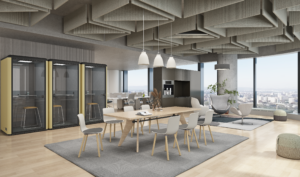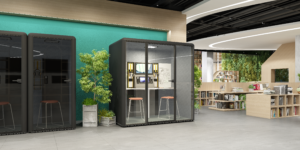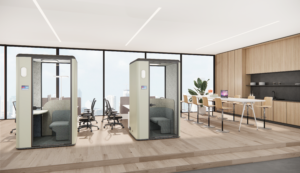As the landscape of work undergoes rapid transformation, the demand for adaptable and technologically integrated work environments is increasing. Soundproof booths, or office pods, are evolving to meet these changing needs, combining flexibility, sustainability, and high-tech features to create optimal workspaces. This article explores how the design of soundproof booths is being shaped by the future requirements of the workplace.

Flexibility and Modularity: Modern work dynamics require spaces that can easily adapt to various activities and team sizes. Soundproof booths are being designed with modularity and flexibility in mind, allowing for easy reconfiguration or relocation within an office layout. This adaptability supports a dynamic work environment where the needs of teams can change rapidly. For instance, booths can be expanded or contracted with modular components, making them suitable for everything from individual work to small group collaborations.
Sustainability in Design: There is a growing emphasis on the environmental impact of office furniture and constructions. Future designs of soundproof booths are focusing on sustainability, using recycled materials and renewable resources to minimize ecological footprints. Features like energy-efficient lighting and ventilation systems are becoming standard, aligning with global sustainability goals. Additionally, manufacturers are adopting practices that reduce waste and energy consumption during production, further enhancing the eco-friendliness of these office solutions.

Seamless Integration with Workspace Management Systems: The design of soundproof booths is evolving to include seamless integration with workspace management systems. This allows for better monitoring and control of booth usage, optimizing efficiency in shared office environments. Integration with reservation systems ensures that these private spaces can be booked and managed effectively, preventing conflicts and enhancing user experience. Advanced scheduling features and real-time availability updates help streamline operations and maximize space utilization.
Ergonomics and Comfort: The health and well-being of users are paramount in the design of modern soundproof booths. Ergonomic features that promote good posture and reduce the risk of strain or injury are integral to their design. Adjustable seating, optimal desk heights, and sufficient internal space to move freely are standard specifications that enhance comfort and usability.

Acoustic Performance: The primary function of soundproof booths is to provide a quiet environment free from external noise. Advances in acoustic materials and design techniques have improved their sound isolation capabilities. Materials such as high-density foam, acoustic glass, and layered wall constructions are used to achieve significant reductions in sound transmission.
The future of workplace design is clearly pointing towards environments that value flexibility, sustainability, and technological integration. Soundproof booths are at the forefront of this trend, providing spaces that not only meet the acoustic and privacy needs of modern workers but also contribute to broader corporate goals of sustainability and employee well-being. As work patterns continue to evolve, the role of soundproof booths in facilitating productive, healthy, and adaptable work environments will undoubtedly expand.
